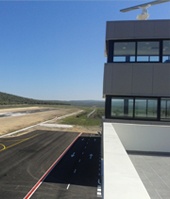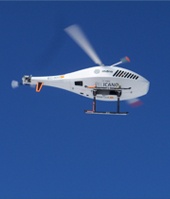Latest news
ATLAS Center host the first Flight Beyond Visual Line of Sight with an UAS in Spain

Today, the ATLAS Test Flight Center has hosted the first flight beyond visual line of sight (BLOS) to be held in Spain with this type of aircraft since the entry into force of the new regulation on the use of aerial systems and unmanned aircrafts (UAS / RPAS), approved by the Ministry of Development early last July .
This is the first civil flight of this kind carried out in Spanish territory with an unmanned aircraft beyond visual line of sight of a pilot, previously authorized and approved by the Spanish Aviation Safety Agency (AESA), the entity that is responsible for the supervision, inspection, and air transport and navigation in Spain. The new regulation on the use of unmanned aircrafts limits civilian flights in non-segregated airspaces to VLOS flights (Visual Line of Sight), where the aircraft can only get up to 500 meters away from the pilot or control center and about 400 feet above the ground.
The flight developed today in ATLAS has been possible thanks to the center’s own segregated airspace, a requirement established in the new regulation that allows UAS / RPAS flights beyond the visual line of sight. Specifically, in the flight performed in ATLAS, in Jaen, the unmanned aircraft has flown away more than 8 Km. from the facilities and has gone through a distance of 18 Km. throughout the test, at an altitude of 3,300 feet above sea level. The entire operation has been coordinated with the Control Center (ACC) in Seville, of the Regional Bureau of Southern Air Navigation of AENA, which manages air traffic across the southern peninsular airspace.
This event is a very important step for positioning the Spanish aerospace industry as a leader in the field of unmanned aircrafts and systems, and it is a demonstration that flights can be performed in Spain with this type of aircraft legally beyond 400 feet high, opening new business and market opportunities for companies in this sector. It also allows performing tests with new technologies related to this field, such as advanced mission capabilities, large autonomous aircrafts, range of communications systems, etc.
In addition, this first BLOS flight places the ATLAS Center at the forefront in the area of research and development of new applications with UAS/RPAS, consolidating its infrastructures as internationally strategic, and as one of those destined to play an important role in the future of this emerging sector, one of those with the greatest scope in the European and world aviation, due to its new civilian and or commercial applications. In fact, ATLAS is one of few places in Europe where flights can be performed in a 30x35Km segregated airspace, with a full civil management.
The flight was carried out by specialized pilots of the Advanced Aerospace Technology Center (CATEC) using the Viewer aircraft, which has a wingspan of 4.8 meters, a maximum takeoff weight (MTOW) of 15 Kg., and a cruising speed of 21 m/s (about 70 km./hr or 40 knots). It is an electric airplane with about 90 minutes flight autonomy, and 2.5 kg payload. To perform the test, the Viewer included a transponder to facilitate appropriate monitoring by the Center for air Traffic Control.
This is the first civil flight of this kind carried out in Spanish territory with an unmanned aircraft beyond visual line of sight of a pilot, previously authorized and approved by the Spanish Aviation Safety Agency (AESA), the entity that is responsible for the supervision, inspection, and air transport and navigation in Spain. The new regulation on the use of unmanned aircrafts limits civilian flights in non-segregated airspaces to VLOS flights (Visual Line of Sight), where the aircraft can only get up to 500 meters away from the pilot or control center and about 400 feet above the ground.
The flight developed today in ATLAS has been possible thanks to the center’s own segregated airspace, a requirement established in the new regulation that allows UAS / RPAS flights beyond the visual line of sight. Specifically, in the flight performed in ATLAS, in Jaen, the unmanned aircraft has flown away more than 8 Km. from the facilities and has gone through a distance of 18 Km. throughout the test, at an altitude of 3,300 feet above sea level. The entire operation has been coordinated with the Control Center (ACC) in Seville, of the Regional Bureau of Southern Air Navigation of AENA, which manages air traffic across the southern peninsular airspace.
This event is a very important step for positioning the Spanish aerospace industry as a leader in the field of unmanned aircrafts and systems, and it is a demonstration that flights can be performed in Spain with this type of aircraft legally beyond 400 feet high, opening new business and market opportunities for companies in this sector. It also allows performing tests with new technologies related to this field, such as advanced mission capabilities, large autonomous aircrafts, range of communications systems, etc.
In addition, this first BLOS flight places the ATLAS Center at the forefront in the area of research and development of new applications with UAS/RPAS, consolidating its infrastructures as internationally strategic, and as one of those destined to play an important role in the future of this emerging sector, one of those with the greatest scope in the European and world aviation, due to its new civilian and or commercial applications. In fact, ATLAS is one of few places in Europe where flights can be performed in a 30x35Km segregated airspace, with a full civil management.
The flight was carried out by specialized pilots of the Advanced Aerospace Technology Center (CATEC) using the Viewer aircraft, which has a wingspan of 4.8 meters, a maximum takeoff weight (MTOW) of 15 Kg., and a cruising speed of 21 m/s (about 70 km./hr or 40 knots). It is an electric airplane with about 90 minutes flight autonomy, and 2.5 kg payload. To perform the test, the Viewer included a transponder to facilitate appropriate monitoring by the Center for air Traffic Control.
Excellent technological and scientific facilities to test light and tactical UAS or RPAS

Unique center in Europe for the RPAS experimentation technologies and air traffic management

Aerodrome with main runway of 800 meters, auxiliary runway of 400 meters and control tower

1,000 km2 Airspace, with the best conditions for flight testing with UAV

Infrastructure and hangars available to the international aerospace companies

A broad platform of unmanned aircraft, from helicopters to electrical aircraft









